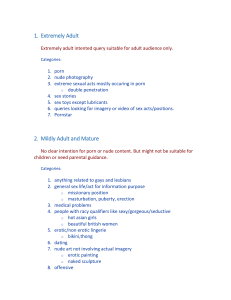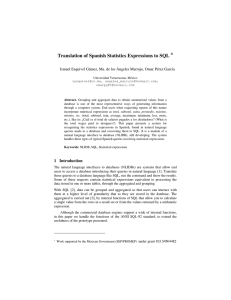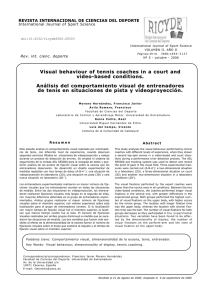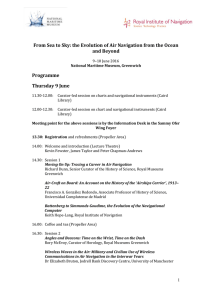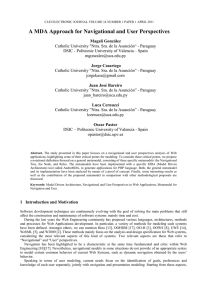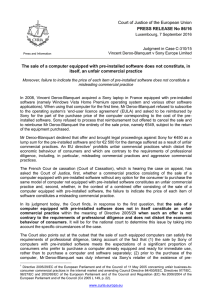Different Users and Intents: An Eye-tracking Analysis of Web
Anuncio
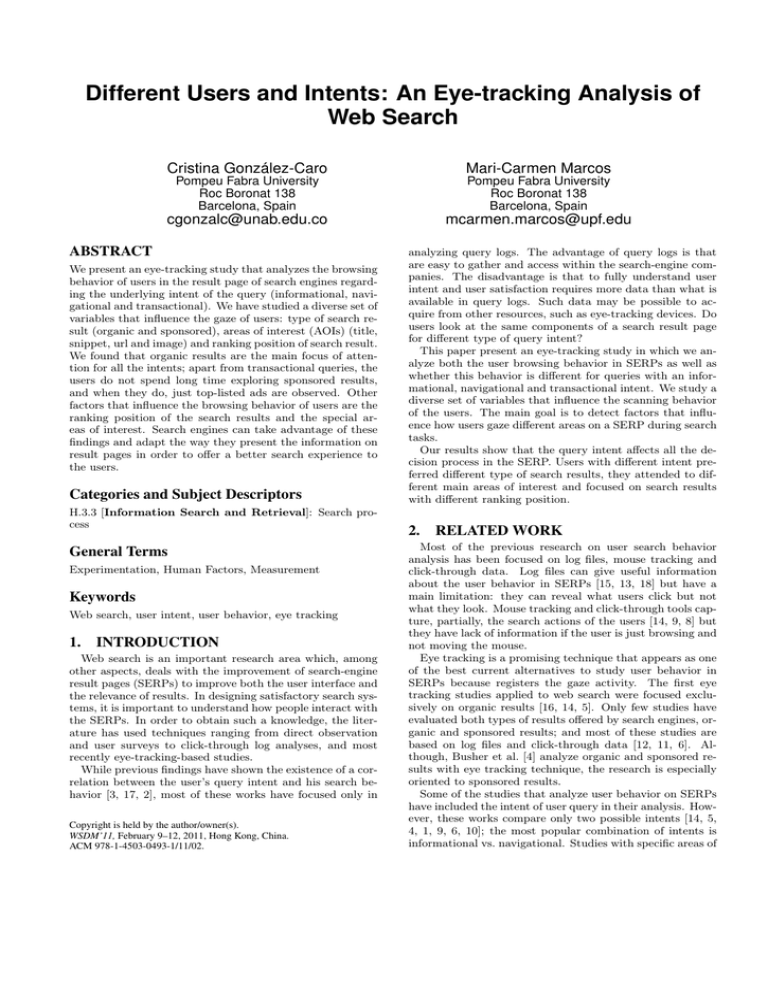
Different Users and Intents: An Eye-tracking Analysis of Web Search Cristina González-Caro Mari-Carmen Marcos Pompeu Fabra University Roc Boronat 138 Barcelona, Spain Pompeu Fabra University Roc Boronat 138 Barcelona, Spain [email protected] [email protected] ABSTRACT We present an eye-tracking study that analyzes the browsing behavior of users in the result page of search engines regarding the underlying intent of the query (informational, navigational and transactional). We have studied a diverse set of variables that influence the gaze of users: type of search result (organic and sponsored), areas of interest (AOIs) (title, snippet, url and image) and ranking position of search result. We found that organic results are the main focus of attention for all the intents; apart from transactional queries, the users do not spend long time exploring sponsored results, and when they do, just top-listed ads are observed. Other factors that influence the browsing behavior of users are the ranking position of the search results and the special areas of interest. Search engines can take advantage of these findings and adapt the way they present the information on result pages in order to offer a better search experience to the users. Categories and Subject Descriptors H.3.3 [Information Search and Retrieval]: Search process General Terms Experimentation, Human Factors, Measurement Keywords Web search, user intent, user behavior, eye tracking 1. INTRODUCTION Web search is an important research area which, among other aspects, deals with the improvement of search-engine result pages (SERPs) to improve both the user interface and the relevance of results. In designing satisfactory search systems, it is important to understand how people interact with the SERPs. In order to obtain such a knowledge, the literature has used techniques ranging from direct observation and user surveys to click-through log analyses, and most recently eye-tracking-based studies. While previous findings have shown the existence of a correlation between the user’s query intent and his search behavior [3, 17, 2], most of these works have focused only in Copyright is held by the author/owner(s). WSDM’11, February 9–12, 2011, Hong Kong, China. ACM 978-1-4503-0493-1/11/02. analyzing query logs. The advantage of query logs is that are easy to gather and access within the search-engine companies. The disadvantage is that to fully understand user intent and user satisfaction requires more data than what is available in query logs. Such data may be possible to acquire from other resources, such as eye-tracking devices. Do users look at the same components of a search result page for different type of query intent? This paper present an eye-tracking study in which we analyze both the user browsing behavior in SERPs as well as whether this behavior is different for queries with an informational, navigational and transactional intent. We study a diverse set of variables that influence the scanning behavior of the users. The main goal is to detect factors that influence how users gaze different areas on a SERP during search tasks. Our results show that the query intent affects all the decision process in the SERP. Users with different intent preferred different type of search results, they attended to different main areas of interest and focused on search results with different ranking position. 2. RELATED WORK Most of the previous research on user search behavior analysis has been focused on log files, mouse tracking and click-through data. Log files can give useful information about the user behavior in SERPs [15, 13, 18] but have a main limitation: they can reveal what users click but not what they look. Mouse tracking and click-through tools capture, partially, the search actions of the users [14, 9, 8] but they have lack of information if the user is just browsing and not moving the mouse. Eye tracking is a promising technique that appears as one of the best current alternatives to study user behavior in SERPs because registers the gaze activity. The first eye tracking studies applied to web search were focused exclusively on organic results [16, 14, 5]. Only few studies have evaluated both types of results offered by search engines, organic and sponsored results; and most of these studies are based on log files and click-through data [12, 11, 6]. Although, Busher et al. [4] analyze organic and sponsored results with eye tracking technique, the research is especially oriented to sponsored results. Some of the studies that analyze user behavior on SERPs have included the intent of user query in their analysis. However, these works compare only two possible intents [14, 5, 4, 1, 9, 6, 10]; the most popular combination of intents is informational vs. navigational. Studies with specific areas of interest (AOIs) labeled by each single search result, further than organic and sponsored areas, are not common. Busher et al. [4] labeled three AOIs (title, snippet and url) but did not present results for these areas; [10] also did it, but did not present the fixation data; and finally [5] is mainly focused on snippets and do not analyze the other areas. To the best of our knowledge, no study about user behavior in SERPs using eye tracking and considering the intent behind the query has combined all the elements that we are including in this research: both types of search results (organic and sponsored results), four special areas of interests for each single search result (title, snippet, url and image) and the position in the ranked list of the search results. 3. METHODOLOGY This paper analyzes the ocular behavior on SERPs using eye-tracking metrics in order to obtain evidence about how eye movement is determined by the intent behind queries, the type of results, the AOI’s on search results and the rank position of the results. We have run an experiment in which 58 participants had to complete six search tasks using Google or Yahoo! search engines. 3.1 Tasks We designed 18 questions, 11 (61%) with informational intent, i.e., they had to find some specific information about a concrete item; 3 (17%) navigational, i.e., they had to find a specific web page; and 4 (21%) transactional, i.e., they had to find a web page and perform an action. The proportion of queries for each intent is based on the results of previous work [3, 17, 2], which reveal that more than half of the queries in search engines are informational and around 25% are navigational and transactional. The designed questions are about general topics in order to avoid specialization bias. These are some examples of the three type of tasks and their respective queries (original in Spanish): informational intent (Which is the timetable of the Louvre Museum in Paris?, query: horario Louvre), navigational intent (Find the official web page of the Granada Town Hall, query: ayuntamiento de Granada), transactional intent (Find a web page where you can book a room in a hotel in Granada, query: hotel Granada). In total, the users performed 348 tasks: 216 with informational intent, 58 with navigational intent and 74 with transactional intent. Half of the queries were run in Google and the other half in Yahoo!. 3.2 Web search sessions After informing the users about the purpose and the procedure of the study, the eye tracker was calibrated. Afterwards, the participants started with the search tasks using the search engine as they normally would. The SERPs had been downloaded and saved on the hard drive of the participant’s computer, and the queries had been typed in the corresponding search engine. Thus, we can control the results viewed by them and obtain comparable results for their gaze. From here on, participants were free to interact with the search results. The tasks were considered finished when they navigated to a web page clicking on the SERP or after 5 minutes browsing the SERP. During the time of tasks performance, a Tobii T120 Eye Tracker was used to follow user’s eye movements throughout the SERP. Logging of gaze data and maps were done by the software Tobii Studio Enterprise Figure 1: Model of the labeling of areas of interest (AOIs) on a Search Engine Result Page (SERP) Edition, version 1.2. In total, 58 people participated in the study, 25 men and 33 women. The participants had a diverse range of professions and an average age of 28 years in a range of 18 to 61 years. All participants were moderately experienced at Web search. For the 58 participants, we generated 16 task sequences with 6 tasks in each considering a final balance between the three types of intents as we have mentioned before. 3.3 Measures Since all SERPs had similar areas, we created common areas of interest. AOIs are specific rectangular areas that contain gaze zones of potential interest to the users. First of all, we distinguished two main areas corresponding to the two type of search results: organic and sponsored. As sponsored results are in two zones of the SERP, we did another division: ads on the top and ads on the side. Eventually, for each single search result, we labeled four AOIs: title, snippet, URL and image. Figure 1 shows the model of SERP with the defined AOIs. In order to explore the determinants of ocular behavior on web pages, the study incorporates an analysis of two dependent variables: fixation frequency and fixation duration. Fixations are defined as spatially stable gaze duration, approximately 200-300 milliseconds, during which visual attention is directed to a specific area of the visual display. Fixation frequency refers to the times that user fixes his attention on a specific point of the screen. We have measured the number of fixations in each AOI and the duration (ms) of each fixation. Considering the intent of the query, both measures were explored as function of independent variables: type of search result, areas of interest in each single search result and ranking position of the results. We decided to classify the tasks in the three types of intent indicated by [3]. We chosen just the three first results to label with AOIs because of “the golden triangle” [10], that is, the area of the first results receives most of the gazes in a SERP. As we wanted to analyze this zone, we chose the three first top ads and the three first organic results, and for having a similar number of results in each zone we labeled the three first side ads too. Table 1: Mean fixation frequency and fixation duration for task on a SERP. Fixation Freq. Fixation Dur. (ms) All 8.37 5991 Informational 9.50 6484 Navigational 6.80 5355 Transactional 8.81 6133 4. ANALYSIS OF USER BEHAVIOR In this section, we analyze how the user behavior on a SERP varies for different query intents. From the 58 participants recruited for the study we recorded usable eye tracking data for 301 of the 348 search tasks that they performed. We discarded some search tasks because of stability problems with the eye tracking tool and/or incomplete data. Table 1 shows the distribution of user’s fixation in the SERPs, as well as the mean time that users spent in these pages. The users had longer mean fixation durations on SERPs for informational and transactional queries, for navigational queries users shown less time fixating information. Since mean fixation duration and fixation frequency are taken as indicators of task difficulty and information complexity [7], the results of Table 1 suggest that informational and transactional queries demand from the users a harder examination of the SERP. The results of the ANOVA test indicated that there is a significant difference between the intent of the query and the total processing time (F= 619.85, p < .005) and the total number of fixations (F= 253.04, p < .005) of the users on SERPs. From these initial results we establish some facts: first, the number of fixations and the time that a user invests examining a Web search result page is not high and second, the underlying intent of the queries influences the little attention that users devote to the SERP. It is important for Search Engines and related services to understand how the users are examining SERPs and extracting the maximum knowledge from the user interactions with Web search results. In the following sections we present an analysis of several elements of Web search results that might affect the user behavior, we focused in how the effect of these elements varies regarding to the intent of the queries. 4.1 Query Intent and Type of Search Result Despite the general idea that organic results are more relevant to queries with informational intent and sponsored results are more relevant to queries with transactional intent (mainly for commercial oriented queries) [11]; it is important to establish which is the real behavior of the users on SERPs when they place queries with different intent on the search engine. Are users of transactional queries more interested on sponsored links? What about users with navigational queries, what kind of results are they interested in?. 4.1.1 Organic vs Sponsored Results. Among the total of evaluated SERPs, only 36% of the pages included sponsored links, it is reflected in the the distribution of the attention of the users on these areas of the SERP: informational (organic=97.4%, sponsored=2.6%), navigational (organic=92.4%, sponsored=7.6%), transactional (organic=71%, sponsored=29%). In Table 2 we can see the average gaze duration for each type of intent broken Table 2: Average gaze duration for type of intent broken down by type of search result. Organic Sponsored F (ms) (ms) (p< .005) Informational 5814 447 1676.9 Navigational 4757 530 305.28 Transactional 2840 1505 282.54 down by type of search result. As we can observe, organic results capture most of the attention of the users when examining SERPs. Among the three intents, organic results have at least 70% of the accumulated number of fixations, these results agree with previous work concerning organic links [6, 4]. Informational and navigational queries are the two type of intent with highest proportion of fixation and gaze duration on organic results. Although informational and navigational intents queries present almost the same distribution of fixations on organic results, the average gaze duration for each intent is not the same. Users spend more time in SERPs when they are dealing with informational tasks, indicating that these tasks require a deeper analysis of the SERP. For navigational tasks, users have also long number of fixations on organic results but a lowest time of gaze duration; usually users tend to go directly to the site they have in mind and hence their fixation time on search results is shorter. Although the accumulated attention for sponsored links is substantially lower than for organic links, there is an interesting behavior of transactional queries with this kind of results. Transactional queries are the only queries that show a considerable percentage of fixation attention on sponsored links (almost 30%). The percentage of attention of navigational queries on sponsored links is very low (less than 10%) and for informational queries that percentage is not representative (less than 3%). If we observe the average gaze duration of all the queries on sponsored links (Table 2), the trend that we found in the number of fixations is confirmed, the users invest an important time on sponsored results only for transactional queries. Figure 2 shows heat maps and gaze plots for queries with different intents. Overall, our findings show that organic results are the main focus of attention for informational, navigational and transactional queries. Although transactional queries exhibit an important proportion of attention on sponsored links, it does not mean that sponsored links are more important than organic links for queries with this type of intent. With exception of transactional queries, the users do not spend too much time exploring sponsored links. 4.1.2 Location of Sponsored Results on SERPs. Sponsored links are not originally designed to fully satisfy all the needs of the users, actually sponsored links are created to cover a target group of user needs: those that are related with commercial transactions. From this point of view and considering our previous findings, we could say that sponsored links serve to the purpose for which they were created, that is, ads are drawing the attention of users who are involved in transactional queries. One of the major challenges for search advertising is extracting the maximum utility of the attention that they are drawing from search engine users. In this direction, a relevant factor is knowing Figure 2: Heat maps (top) and gaze plots (bottom) for three queries with different intent. what are the preferences of the users with respect to the location of the sponsored links: do the users prefer top-listed or side-listed sponsored results?. Figure 3 shows the percentage of the number of fixations of the users on sponsored results from both locations (top, side). Figure 4 shows the mean gaze duration for each query intent on sponsored links. The results suggest that top-listed sponsored links are more viewed than side-listed sponsored links for all types of queries. As we already established, transactional queries appear as the group of queries with a highest proportion of attention on both types of sponsored links. Despite that participants even have fixed their attention on side-sponsored links, their fixations are very short. Overall, 70% of the visual fixation on sponsored search results were on top-sponsored links and 30% on side-sponsored links; however, with exception of transactional queries, gaze durations on side-sponsored links were minimum. The mean gaze duration of the three types of intent with the two types of sponsored links are statistically significant: informational (F=62.59, p<0.001), navigational (F=37.79, p<0.001), transactional (F=81.92, p<0.001). In the following sections we show a deeper analysis of the user behavior regarding the specific areas of a SERP. 4.2 Query Intent and Areas of Interest In this section we want to establish if users attend to different AOIs of the search results for queries with different intent. Figure 5 shows the distribution of number of fixations and gaze durations on AOIs for organic results. There are several differences for the distribution of visual attention of the users (number of fixations and gaze duration) on each AOI with respect to the intent. As we expected, because of its size, the area that attract the highest number of fixations and gaze durations for all the queries is the snippet. Specifically the distribution on the snippet is: informational 51%, navigational 42% and transactional 43%. Users spend more time on the snippet for informa- tional queries, confirming that the snippet is an important element to help users to determine if a given result is likely to have the information they are looking for. These findings are consistent with the results reported on [5]. The second area with high number of fixations and gaze durations for the queries is the title. The distribution of visual attention of the title AOI is different than those of the snippet AOI. Titles are more relevant for transactional and navigational queries and in lower proportion for informational queries. The URLs show the same proportional distribution of visual attention than titles, that is, transactional and navigational queries in the first place of the user preferences followed by the informational queries. The attention bias on the tittle and the URL for transactional and navigational queries suggests that users with such intent are specially interested on the identification of the web sites to which search results belong. The only type of intent that devoted a portion of time examining images was the navigational intent. Despite the proportion of total time and fixations invested for navigational queries on images is not high, it is representative, if we consider that informational and transactional queries did not register gazes on images. Finally, considering that only the transactional queries showed significant visual attention on sponsored search results, we show the distribution of the attention for these queries on sponsored links regarding the AOIs (Figure 6). The most important AOI when users examining sponsored links is the title, followed by the snippet and the URL. Although the snippet AOI exhibits a higher number of fixations than the URL AOI, it is important to notice that the gaze duration is almost the same for the two AOIs. Given that the snippets have a longer size, this result suggests that users spend more time examining each individual URL than each snippet. 50 45 60 Informational Navigational Transactional Informational Navigational Transactional 50 35 40 Percenttage (%) Percentag ge (%) 40 30 25 20 30 20 15 10 10 5 0 Fixation Gaze Fixation Gaze Frequency Duration Frequency Duration 0 Top Listed Links Side Listed Links Figure 3: Percentage of number of fixations for each type of sponsored link broken down by query intent. Title Navigational Transactional 45 Image Fixation Frequency Gaze Duration Snippet URL 40 1200 35 1000 Porcentage ((%) Fixation Durration (ms) URL Snippet 50 Informational 800 600 400 200 0 30 25 20 15 10 5 0 Top Listed Links Side Listed Links Figure 4: Average gaze duration for each type of sponsored link broken down by query intent. 4.3 Fixation Gaze Frequency Duration Figure 5: Distribution of visual attention on AOIs broken down by query intent. 1600 1400 Fixation Gaze Frequency Duration Query Intent and Ranking Position of Search Results Overall, we can say that the rank of a result is relevant for the users (see Table 3). For all types of search results, the first ranking position collected the highest attention. For organic results the first position gathered more than 40% of attention for informational and navigational queries and 30% for transactional queries. Users devoted large fraction of their fixations on organic ranking positions 1 and 2. For the three query intents the accumulated number of fixations on the first two organic results are: navigational (76.84%), informational (75.46%) and transactional (56.74%). Although navigational queries were not the type of queries that accumulated the major number of fixations in organic results, they were the queries with the largest number of fixations on organic ranking positions 1 and 2. This finding suggests that these two ranking positions are particularly relevant for navigational queries. With respect to the ranking position of search results, the distribution of fixations on sponsored results is different to the fixations on organic results. Informational and navigational queries do not present significant fixations on sidelisted sponsored results and for top-listed sponsored results: the percentage of fixations is larger than 1% only for the first ranking position. The situation is different for transactional queries: 29% of the fixations of these queries were for Title Figure 6: Distribution of visual attention of transactional queries on AOIs for sponsored links. sponsored results, 21.28% on top-listed results and 7.80% on side-listed results. Again, the most relevant ranking position is number 1. Unlike to [12], where they found that the ranking position did not affect sponsored result viewing, our findings suggest that ranking position and the location on the SERP of the sponsored search results influence sponsored result viewing. The lower the rank (closer to the top of the page) the more likely a user will check the search result. Figure 7 shows the distribution of fixations on organic results broken down by AOIs. The specific areas of interest are influenced by the query intent. The viewing pattern for informational queries is homogenous along the three organic results: the snippet with the highest number of fixations, followed by the tittle and finally the URL. Snippet and title are also the most important AOIs for navigational queries, but in this case the distribution of fixations varies from the first to the second organic result. In the first organic result the snippet is remarkably more important than title for navigational queries and in the second organic result the title is slightly more relevant than the snippet. URL is also an important element for navigational queries, especially in the first result. Transactional queries have a balanced distribution of fixations on the snippet, tittle and URL for the first organic result. Finally, Figure 8 shows the distribution of fixations on AOIs for sponsored results. Compared with the organic re- 30 Informational 27 Navigational Transactional 24 Percentang ge (%) 21 18 15 12 9 6 3 0 Title Snippet URL Image Title Snippet URL Rank 1 Rank 2 Image Title Snippet URL Image Rank 3 Figure 7: Percentage of visual fixations on AOIs for organic results broken down by ranking position. Table 3: Percentage of number of fixations on search results broken down by rank and query intent. Rank Organic1 Organic2 Organic3 Top-Ad1 Top-Ad2 Top-Ad3 Side-Ad1 Side-Ad2 Side-Ad3 Total Informational 47.17 28.21 21.92 0.85 0.85 0 0.69 0.11 0 100 User’s Intent Navigational 42.11 25.36 13.64 2.63 0.72 0.96 1.20 0.48 0 100 Transactional 30.02 26.71 14.18 10.87 5.67 4.73 5.67 1.65 0.47 100 sults, there are some changes in the order of relevance of the AOIs for each query intent. In the first top-listed sponsored result for example, informational queries devote a considerable percentage of visual fixations to the URL and the attention on the title decreases. The snippet is still the area with the largest number of fixations for informational queries in this result. Navigational queries focused all their fixations in the title and URL, there are not fixations on the snippet in the first top-listed result for these queries. In the case of transactional queries, snippet and title with almost the same percentage of number of fixations, accumulated most of the visual attention in the the first top-listed result. In the second and third top-listed result, transactional queries focused the attention on the URL and the title, the snippet is almost ignored. Overall, for top-listed sponsored results the title and the URL are the most important areas of interest for the users. Although the number of fixations on side-listed sponsored results is very low, we can analyze the visual attention that users devoted to the first result. In general, the viewing behavior of users for the first side-listed sponsored result is similar to the viewing behavior of users for the organic results (keeping the proportion on the number of fixations): for informational queries the snippet captures most of the visual fixations of the users, followed by title and at the last place the URL. For transactional queries, we observe again, a balanced distribution of fixations on the snippet, tittle and URL for the first side-listed result and in the second and third side-listed results the most important AOI was the snippet. Interestingly, organic and side-listed sponsored results have same trends for visual attention on AOIs, while top-listed sponsored results exhibit a different distribution of the user’s visual attention. 5. DISCUSSION AND DESIGN IMPLICATIONS This paper provides new data to the field of search engines user’s behavior. The results give interesting keys to the search engines companies to adapt the SERPs to the user’s needs regarding their intents. At the same time, these results provide evidence of the importance of obtaining a good rank in the SERP, which is extremely useful for webmasters, search engines optimization (SEO) experts, and the search engine marketing (SEM) professionals. Search engines. Nowadays, the way that search engines show the results in the SERP does not vary considering different user needs or intents. In this study we show that the intent determines the visual behavior on the search engine interface. Users could take more advantage from the SERP if search engines were able to adapt the way the information is shown to the intent of the queries. This study has considered different parts of the search engine interface with the aim to establish how these variables influence on the user’s gaze. The title and the URL can not suffer any variation because they come directly from the referred Web page, but the snippet, which is generated automatically by the search engines, could be adapted to the particular intent of the user. Moreover, the snippet is the area that attracts more looks, so it should be studied carefully to provide the information that will help the user to make a better decision. How could search engines build different snippets in relation to the user’s intents? We have observed that fixation 14000 Informational Navigational Transactional 12000 Gaze duration (ms) 10000 8000 6000 4000 2000 Rank 1 Rank 2 Rank 3 Rank 1 Top Rank 2 URL Snippet Title URL Snippet Title URL Snippet Title Url Snippet Title URL Snippet Title URL Snippet Title 0 Rank 3 Side Figure 8: Accumulated gaze time on AOIs for sponsored results broken down by ranking position. duration is minor in navigational queries than in the other two types of query intent, but at the same time, users have a considerable number of fixations in this type of searches (see Table 1). We think that the reason is that when users are looking for a particular web page they don’t read too much, they just check if any of the results matches to the Web page they are looking for. For this type of queries, SERPs should offer just concise information, focusing on titles and with brief snippets. On the other hand, showing side ads for these users is not worth; in fact they are not looking at this area. However, complete and longer snippets on organic results should be showed for informational and transactional queries: as the results show, users spend more time fixating information with this type of queries. Search engines can obtain information for the snippet from the meta tag ”description” in the source code of the html files. This area should be filled properly by the webmaster of the website, as well as the title information. Webmasters and SEO experts. The results of this study provide evidence of the importance of obtaining a good ranking position in the SERP, according with our findings only first results receive the attention of the users in most cases. This evidence is the base of the work of SEO experts, who usually show to their clients the result of their work with traffic data. In this study we reinforce the knowledge they have and offer objective data with detailed information about users’ behavior on the SERP. In practical terms, the results point out the need to provide good titles, legible URLs and good meta data in the source code, all in the hands of webmasters and essential for SEO. Experts in Search Engine Marketing. People in charge of marketing who want to do a search engine campaign will see in this paper that ads are only important for the users when they have a transactional intent. Among the two possible locations -top and side-, ads placed on the top are always more visible than those that are in the side. Moreover, as in this kind of results short snippet are allowed, we recommend to choose good titles in order to catch the users attention, mainly because clicks on ads are more im- pulsive than on organic results. The URL showed to be an important area in ads too, at least users look at it a significant number of times. As a consequence, the title and URL should be shown in an easy way to be read, recognized and remembered. 6. SUMMARY AND CONCLUSIONS We have presented an analysis of how the behavior of users who examine a SERP varies for different query intents. Users with different intent prefer different type of search results, draw their attention to different main areas of interest, and focus on search results with different ranking position. We can assess that organic results are the main focus of attention, while the users do not spend long time exploring sponsored results, apart from transactional queries, and when they do, they only look at top-listed ads. We also confirmed that the ranking position of the results is relevant for the users: the first ranking position always collects the highest fraction of visual attention, and some differences can be observed between second and third position. The relevance of the different elements of each result (AOIs) also changes depending on the intent. Our results show that the query intent affects all the decision process in the SERP. Given that the goal of search engines is to match as well as possible user needs with results found, having a deeper knowledge of how users focus their attention on SERP will help to improve the interface design by positioning the most relevant information at places that users tend to look. This study has opened other possibilities that will be considered in a future work as we have collected data from users. Specifically, demographic information like genre and age, or technological skills and information retrieval skills, as well as satisfaction stated by the participants will be taken into account in a following research. We also can study separately gazes of users who performed searches on Google and users who worked with Yahoo! in order to know if they respond to the same pattern. For this study we have chosen SERPs with AOIs with common elements to allow a reliable comparison. In the future, more complex SERP with multimedia elements as images, maps, and videos can be studied. In the last months some features in SERP have appeared, for instance the advanced search options in the left side of the interface in Google, or a rich snippet in some results with a brief index of the main sections of the website, or information about popularity and price of a product. Also the social network information as the Twitter tweets starts to be shown with the results. These new features affect the way the users gaze the SERP, and their analysis is useful in order to improve the search engine interfaces. As we stated, no previous studies using eye tracking have considered the intent behind the query combining all the elements that we are including in this research. We hope that our findings contribute to a better understanding of the users and that allow search engines and related services to provide a more effective and personalized search experience to the users. 7. ACKNOWLEDGMENTS We would like to thank all the participants of the study. We are especially grateful to AIPO, Tobii Inc. and Alt64, thanks to which we have temporarily had the eye tracker and the software license. 8. REFERENCES [1] A. Ashkan and C. L. Clarke. Characterizing commercial intent. In CIKM ’09, pages 67–76. ACM, 2009. [2] R. Baeza-Yates, L. Calderón-Benavides, and C. González-Caro. The intention behind web queries. In SPIRE’06, volume 4209 of LNCS, pages 98–109. Springer, 2006. [3] A. Broder. A taxonomy of web search. SIGIR Forum, 36(2):3–10, 2002. [4] G. Buscher, S. T. Dumais, and E. Cutrell. The good, the bad, and the random: an eye-tracking study of ad quality in web search. In SIGIR ’10, pages 42–49. ACM, 2010. [5] E. Cutrell and Z. Guan. What are you looking for?: an eye-tracking study of information usage in web search. In CHI ’07, pages 407–416. ACM, 2007. [6] C. Danescu-Niculescu-Mizil, A. Z. Broder, E. Gabrilovich, V. Josifovski, and B. Pang. Competing for users’ attention: on the interplay between organic and sponsored search results. In WWW ’10, pages 291–300. ACM, 2010. [7] J. H. Goldberg, M. J. Stimson, M. Lewenstein, N. Scott, and A. M. Wichansky. Eye tracking in web search tasks: design implications. In ETRA ’02, pages 51–58. ACM, 2002. [8] Q. Guo and E. Agichtein. Exploring searcher interactions for distinguishing types of commercial intent. In WWW ’10, pages 1107–1108. ACM, 2010. [9] Q. Guo and E. Agichtein. Ready to buy or just browsing?: detecting web searcher goals from interaction data. In SIGIR ’10, pages 130–137. ACM, 2010. [10] G. Hotchkiss. Enquiro eye tracking report ii: Google, msn and yahoo! compared, 2006. [11] B. J. Jansen. The comparative effectiveness of sponsored and nonsponsored links for web e-commerce queries. ACM Trans. Web, 1(1):3, 2007. [12] B. J. Jansen and M. Resnick. An examination of searcher’s perceptions of nonsponsored and sponsored links during ecommerce web searching. J. Am. Soc. Inf. Sci. Technol., 57(14):1949–1961, 2006. [13] B. J. Jansen and A. Spink. How are we searching the world wide web? a comparison of nine search engine transaction logs. Inf. Process. Manage., 42(1):248–263, 2006. [14] T. Joachims, L. Granka, B. Pan, H. Hembrooke, and G. Gay. Accurately interpreting clickthrough data as implicit feedback. In SIGIR’05, pages 154–161, 2005. [15] M. Mat-Hassan and M. Levene. Associating search and navigation behavior through log analysis: Research articles. J. Am. Soc. Inf. Sci. Technol., 56(9):913–934, 2005. [16] B. Pan, H. A. Hembrooke, G. K. Gay, L. A. Granka, M. K. Feusner, and J. K. Newman. The determinants of web page viewing behavior: an eye-tracking study. In ETRA ’04, pages 147–154. ACM, 2004. [17] D. E. Rose and D. Levinson. Understanding user goals in web search. In WWW’04, pages 13–19. ACM, 2004. [18] S. Wedig and O. Madani. A large-scale analysis of query logs for assessing personalization opportunities. In KDD ’06, pages 742–747. ACM, 2006.
